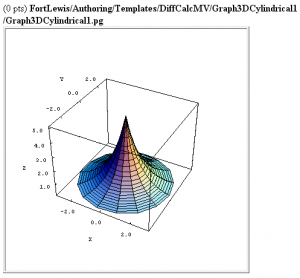Graph3DCylindrical1
This problem has been replaced with a newer version of this problem
Deprecated: Interactive Graphs of Functions in Cylindrical Coordinates
This PG code shows how to make an interactive graph of a function in cylindrical coordinates that is displayed using the LiveGraphics3D Java applet. It is deprecated because Java is no longer universally supported on all web browsers and platforms.
- File location in OPL: FortLewis/Authoring/Templates/DiffCalcMV/Graph3DCylindrical1/Graph3DCylindrical1.pg
| PG problem file | Explanation |
|---|---|
|
Problem tagging: |
|
DOCUMENT(); loadMacros( "PGstandard.pl", "MathObjects.pl", "parserVectorUtils.pl", "PGcourse.pl", "LiveGraphicsCylindricalPlot3D.pl", ); TEXT(beginproblem()); |
Initialization:
We need to include the macros file |
Context("Numeric");
Context()->variables->are(x=>"Real",y=>"Real",r=>"Real",t=>"Real");
$a = random(2,4,1);
$plot = CylindricalPlot3D(
function => Formula("$a*cos((r^2)/4)"),
rvar => "r",
tvar => "t",
rmin => 0,
rmax => 6,
tmin => 0,
tmax => 2*pi,
rsamples => 20,
tsamples => 15,
axesframed => 1,
xaxislabel => "X",
yaxislabel => "Y",
zaxislabel => "Z",
outputtype => 4,
);
|
Setup:
We generate a string of plot data using
Setting |
Context()->texStrings;
BEGIN_TEXT
\{
Live3Ddata(
$plot,
image => "bell-shape.png",
size => [400,400],
tex_size => 600,
tex_center => 1,
scale => 1.1,
);
\}
END_TEXT
Context()->normalStrings;
|
Main Text:
To display the string of plot data
After you construct the graph you like, don't forget to take a screen shot of it and make an image file such as |
$showPartialCorrectAnswers = 1; |
Answer Evaluation: |
Context()->texStrings;
BEGIN_SOLUTION
Solution explanation goes here.
END_SOLUTION
Context()->normalStrings;
COMMENT('MathObject version.');
ENDDOCUMENT();
|
Solution: |
